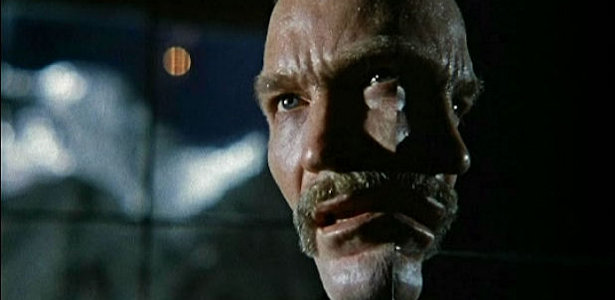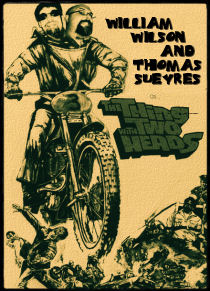In 1976 Paramount and Dino de Laurentiis decided the time was right for a massive rebirth of RKO’s gargantuan sacred cow, King Kong. The film had an all-star cast of Bert I. Gordon proportions, including Charles Grodin who you’d think would be your first casting choice for a giant ape movie. Don’t get me wrong, Grodin is the man and SEEMS LIKE OLD TIMES (1980) is one of my favorite comedies of the era, but ummmm… King Kong? Really? Also, at the time it seemed like the height of technical wizardry with the massive ape actually destroying the pavement when he fell from the, now eerily ill-fated, world trade center. It also grabbed the imaginations of audiences, though not so much their wallets. The film weighed in at a massive $24 million, but only brought in $7 million on its opening weekend. So much for being “the most exciting original motion picture event of all time” as the tag-line proclaimed. Like I said, it grabbed the imaginations of the public and made giant apes a hot commodity. So, I hear you say, where do we go from here? Italy! Ummm, no. Japan! Well, that was in 1962, so again, no. I know, I know, this is a tough one. Get the kimchi ready, we are East bound and down, takin' a trip to Korea!
Thrown together by South Korean filmmakers to cash in on the popularity of the concept (if not the film) and inexplicably shot in 3D, this film actually managed to beat KING KONG (1976) in to theaters by a couple of months. It’s a smart move as anticipation was high and billfolds were ripe for the plucking. Originally titled THE NEW KING KONG, RKO slapped a lawsuit on the producers for (at the time) a suitably colossal $1.5 million. You’d have to multiply the budget of this film an awful lot to get it anywhere near that number, so the American distributors opted for the title A*P*E which, believe it or not, is a parody of M*A*S*H, which was, as you know, also in Korea. Get it? Phew!
During the opening credits there is a thank-you to the US military, leading to the question, how in the hell did they get the co-operation of the US military?! Are the guys in green so freakin’ bored that you can just call up Col. Henry Blake and say, “hey, we’re shooting a movie about a giant ape, can we borrow some tanks, men, jeeps and maybe an officer or two?” Maybe they ran it past Radar O'Reilly first.
Imagine Bill Rebane went to Korea and made a movie about a giant ape… Got the picture? No? Then I guess I’ll have to fill in the details.
The film opens with the captain of a freighter having a conversation with a mate about the “big guy” they have below decks who was apparently caught in Harlem (umm… since when are the Empire State Building or the World Trade Center anywhere near Harlem? If they are referring to his fall off the Empire State Building he would have had to have fallen 6 miles horizontally!). No sooner than you can say “are these actors delivering their lines under hypnosis?” than a *ahem* giant ape fist (or a the cheapest paper-mache ape fist imaginable), rips through the deck of a cheap miniature ship and so begins the rampage through Seoul. Err… well, sort of. First he needs to get in a brawl with a dead shark. Yes, I said “dead shark”. In an attempt to errm, “ape” the famous Kong vs. Alisaur scene in the original film, a dude in the cheapest ape suit imaginable “brawls” with a painfully obviously inert opponent in what is possibly one of the most jaw-droppingly bizarre scenes that I can think of. The shark just flops around as the “ape” really badly pretends to wrestle it (or maybe wash it, it’s hard to tell), finally tearing its jaws open to defeat it. From there it’s an attack on a military base where the ape throws tin cans painted up to look like fuel drums. But wait! There’s more!
The meat of the plot, such as it is, concerns a famous American actress Marilyn Baker (Joanna Kerns) who comes to Korea to make a film that seems to be entirely about her being sexually assaulted in historic Korean locations while comic music plays on the soundtrack (don’t ask me, I don’t know). Her amorous boy-friend Tom Rose (Rod Arrants) is a reporter who decides to take a job in Korea so he can annoy the crap out of her. You can see where this is heading right? Yeah, the famous actress is snatched up by the ape who seems somewhat less pre-occupied by her than is her stalker boyfriend. That doesn't mean Mr. Ape doesn’t hunt her down like a bloodhound on the Scottish moors! Would you believe a short-haired terrier in a suburban tract home? Our nameless ape lazily smacks around buildings, poking his nose in windows, disrupting family dinners, pool games and a hooker with her greasy, chubby American john. Why do I get the feeling Asians in the ’70s thought all Americans were fat, horny and shellacked with brylcreem? C’mon, we don't use brylcreem! Erm... anymore.

For whatever reason, the filmmakers decided that this movie demanded 3D effects and at no point would you ever want to see them more than in a scene in which a group of kids go to the most pathetic, deserted amusement park ever (titled “Familyland” in Disney script) and play on the see-saw. Hell yeah brother, you heard me right! 3D see-saw action! My life is complete. Actually I have to hand it to them with one 3D scene. Cut to a pastoral scene in which a group of martial artists are practicing with all manner of weapons and suddenly a “giant ape” attacks! Or rather is in a completely different place being shot by a second unit crew. Hell, what am I saying? These guys couldn’t afford a second unit crew! Still it’s pretty damn funny seeing them try to edit the martial artists fighting back against the ape, particularly in the miracle of 3D! The first half of the movie is pretty much a pastiche of scenes like these that are pretty damned amusing. In one scene a US military grunt is driving his Jeep along a road and WHAM! a wooden beam that is apparently growing out of a Korean Square Branch Tree that was planted in the middle of the road, slams right through his window (and of course into the audience). The soldier then stops, jumps out of the vehicle and looks around in complete bewilderment at the destroyed US base that he was just driving through completely intact! Unfortunately the second half descends into some slightly tedious destruction of cheap miniatures and some really painful intentional camp added by the US producers. After a farmer finds a giant footprint, some heated phone calls are made to the local US military outpost where the captain says “this is Korea not Scotland, the Loch Ness Monster couldn’t make it over the Berlin Wall!” Phew!
On the other hand, there is plenty of stuff to be entertained by:
- There is plenty of dialogue about how great certain famous Korean landmarks are, but never actually go to them or even show them.
- We discover that in Asia, it is Americans that can’t drive.
- “Scientific phenomenon? Bullshit!”
- The extras show far more enthusiasm than the ape.
- Korean kids are so poor they can laugh for hours at a marionette having what appears to be an epileptic sezure.
- Toy tanks can make giant apes vomit blood.
- You can destroy Korean tanks by throwing rocks at them.
- There is plenty of dialogue about how great certain famous Korean landmarks are, but never actually go to them or even show them.
- We discover that in Asia, it is Americans that can’t drive.
- “Scientific phenomenon? Bullshit!”
- The extras show far more enthusiasm than the ape.
- Korean kids are so poor they can laugh for hours at a marionette having what appears to be an epileptic sezure.
- Toy tanks can make giant apes vomit blood.
- You can destroy Korean tanks by throwing rocks at them.
I may not know this for a fact, but I’m pretty sure this is Kim Jong-Il’s favorite movie. I mean, what movie would a megalomaniacal, 5’ tall, platform-shoe wearing “supreme leader” in North Korea find the most arresting? Why a movie about a giant that destroys Seoul of course (I was going to make a joke about giant monkey’s and spankage, but as you know we’re too sophisticated for that)!
In the end this film is appropriately malnourished with some of the sloppiest editing I have ever witnessed with the ends of dialogue sequences being shorn of their final words. Even so, the rather uninspired final half and the American inserts that desperately try to salvage the film by trying to make out that it’s intentionally bad, kind of make it miss the mark. I’d love to see the original version, but that’s probably not going to happen any time soon.







































































